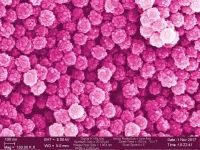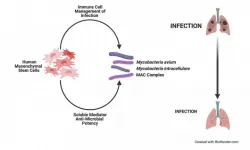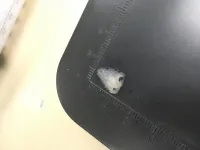(Press-News.org) Wherever scientists look, they can spot them: whether in remote mountain lakes, in Arctic sea ice, in the deep-ocean floor or in air samples, even in edible fish - thousands upon thousands of microscopic plastic particles in the micro to millimeter range. This microplastic is now even considered one of the defining features of the Anthropocene, the age of the Earth shaped by modern humans.
Microplastics are formed by weathering and physicochemical or biological degradation processes from macroscopic plastic products, such as the tons of plastic waste in the oceans. It is unlikely that these degradation processes will stop at the micrometer scale. And so there is growing concern about the potential harmful effects nanoplastics could have on various ecosystems. "Numerous media reports suggest, through their sometimes highly emotional coverage, that we are facing a huge problem here," says Empa researcher Bernd Nowack, who has long studied the material flows of synthetic micro- and nanoparticles, for example from textiles or tire abrasion, into the environment. But Nowack says at present this statement can hardly be substantiated by scientific findings: "We don't even know how much nanoplastics there is in the different ecosystems."
Huge gaps in knowledge ...
This is primarily because it is enormously difficult in terms of measurement technology to identify artificial nanoparticles made of plastic in environmental samples with thousands and thousands of (natural) particles of similar size. Appropriate analytical methods would first have to be developed, says Denise Mitrano of ETH Zurich. And then it would be a matter of understanding exactly what risk the tiny plastic particles - some of which differ considerably in their chemical composition - pose to humans and the environment, in other words: how dangerous they ultimately are. Adds Nowack, "So we can't justifiably say we have a serious problem here - but we also can't say we don't."
That's because the smaller particles become, the more likely they are to reach organs and tissues that are inaccessible to larger particles. The blood-brain barrier or placenta, for instance, prevents particles and macromolecules from passing through until they reach a certain size - or rather, smallness - thereby protecting the tissues and organs "behind" them, i.e. the brain and fetus, respectively, from potentially dangerous substances such as viruses and bacteria. "Even if we ingest microplastics, for example through our food, they probably do not enter our bloodstream or our brain, but are simply excreted again," says Peter Wick, head of Empa's Particles-Biology Interactions lab, who studies the interactions of nanoparticles with biological systems. "With nanoplastics, we can't be so sure."
... and great need for research
Because of the enormous gaps in current knowledge, research into nanoplastics must thus be intensified, conclude Mitrano, Wick and Nowack. However, this should be done as systematically and broadly as possible - and with a cool head. After all, emerging pollutants do not always turn out to be as dangerous as originally assumed. "Our society initially adopts a zero-risk attitude toward many things that are new and unknown," Wick says. And that's understandable, he adds, especially in the case of nanoplastics, because, after all, "who wants plastic in their food?"
The solution to the problem, however, is as simple (at least in theory) as it is complex. On the one hand, a large proportion of nanoplastic particles are produced by the degradation of macro- and microplastics. Less plastic in the environment, therefore, reduces the amount of nanoplastics, and here every one of us can help stop polluting the environment with plastic waste. On the other hand, nanoplastics can also be created during the use of plastic products - for example, through abrasion - without the user being able to do anything about it. Indeed, our society is hardly possible without plastic. "The various polymers simply have too many positive properties for that," says Bernd Nowack.
INFORMATION:
Literature
DM Mitrano, P Wick & B Nowack; Placing nanoplastics in the context of global plastic pollution. Nature Nanotechnology (2021). https://doi.org/10.1038/s41565-021-00888-2
On September 28, 2018, an inexplicably large tsunami devastated the Indonesian coastal city of Palu and several others nearby. Between the tsunami and the magnitude 7.5 earthquake that caused it, some 4,340 people were killed, making it the deadliest earthquake that year.
The tsunami's waves reached around six meters high, which was a shock to geophysicists who had believed that earthquakes along a strike-slip fault could only trigger far smaller tsunamis for that particular region. Now, new research describes a mechanism for these large tsunamis to form, and suggests that other coastal cities that were thought to be safe from massive tsunamis may need to reevaluate their level of ...
Daegu Gyeongbuk Institute of Science and Technology (DGIST) scientists in Korea have developed algorithms that more efficiently measure how difficult it would be for an attacker to guess secret keys for cryptographic systems. The approach they used was described in the journal IEEE Transactions on Information Forensics and Security and could reduce the computational complexity needed to validate encryption security.
"Random numbers are essential for generating cryptographic information," explains DGIST computer scientist Yongjune Kim, who co-authored the study with Cyril Guyot and Young-Sik Kim. "This randomness is crucial for the security of cryptographic systems."
Cryptography is ...
University of South Australia researchers have identified an enzyme that may help to curb chronic kidney disease, which affects approximately 700 million people worldwide.
This enzyme, NEDD4-2, is critical for kidney health, says UniSA Centre for Cancer Biology scientist Dr Jantina Manning in a new paper published this month in Cell Death & Disease.
The early career researcher and her colleagues, including 2020 SA Scientist of the Year Professor Sharad Kumar, have shown in an animal study the correlation between a high salt diet, low levels of NEDD4-2 and advanced kidney disease.
While a high salt diet can exacerbate some forms of kidney disease, until now, researchers did not realise ...
Pioneering neural recordings in patients with Parkinson's disease by UC San Francisco scientists lays the groundwork for personalized brain stimulation to treat Parkinson's and other neurological disorders.
In a study published May 3rd in Nature Biotechnology, UCSF Weill Institute for Neurosciences researchers implanted novel neurostimulation devices that monitor brain activity for many months, with and without deep brain stimulation (DBS) therapy. Pairing the brain recordings with wearable monitors of movement, they identified patterns of brain activity corresponding to specific movement abnormalities associated with Parkinson's. Their research provides the first ...
HOUSTON - Researchers have found the right formula for mixing a cement that does double duty as a structural material and a passive photocatalytic water purifier with a built-in means of replenishment: simply sand down the material's surface to refresh the photocatalytic quality.
They found this recipe using a few very precise physical laboratory experiments whose data were then greatly amplified using a computational method called combinatorics that tested thousands of combinations of cement composites and their photocatalytic qualities.
The results, say the researchers from C-Crete Technologies and Rice University, indicate ...
Blood may seem like a simple fluid, but its chemistry is complex. When too much potassium, for instance, accumulates in the bloodstream, patients may experience deadly irregular heart rhythms.
Cardiovascular scientists at Virginia Tech's Fralin Biomedical Research Institute at VTC are studying why.
In a new study, published in Pflügers Archiv European Journal of Physiology, the research team led by Steven Poelzing, associate professor at the institute, describes how subtle changes in potassium, calcium, and sodium levels regulate heartbeats.
Poelzing ...
DALLAS (May 3, 2021) - Researchers from the Center for BrainHealth® at The University of Texas at Dallas are investigating a potential new early indicator of the decline toward Alzheimer's disease: measuring the energy metabolism of the living human brain using cutting-edge imaging techniques.
The scientists devised a unique way to illustrate energy consumption and reserves in the brain with phosphorus magnetic resonance spectroscopy using an ultra-high-field 7 Tesla MRI scanner. Their results suggest that neurological energy metabolism might be compromised in mild cognitive impairment (MCI), the stage of decline between healthy ...
A study published today in Nature Communications shows that the drug rucaparib has been effective in treating certain types of ovarian cancers if used early in treatment, after a diagnosis, and before the cancer cells build up a resistance to chemotherapy.
Rucaparib is in a relatively new class of drugs - Poly(ADP-ribose) polymerase or PARP inhibitors - which have been approved for therapy in ovarian cancers. This study provides insights into both how the cancers resist treatments, and which patients may respond favorably to the drug, said lead author Dr. Elizabeth Swisher, a UW Medicine ...
Durham, NC - A study released today in STEM CELLS Translational Medicine offers hope for those suffering from a chronic, difficult to treat condition called non-tuberculous mycobacteria (NTM) lung infection. The study describes how researchers at Case Western University developed a new model of NTM lung infection and then used it to show how effective human mesenchymal stem cells (hMSCs) are in treating this condition - and even which donor cells might be best for doing so.
"The potential to use human mesenchymal stem cells to treat difficult lung infections is promising," said Anthony Atala, M.D., Editor-in-Chief of STEM ...
PULLMAN, Wash. -- Professor Arda Gozen looks to a future someday in which doctors can hit a button to print out a scaffold on their 3-D printers and create custom-made replacement skin, cartilage, or other tissue for their patients.
Gozen, George and Joan Berry associate professor in the Washington State University School of Mechanical and Materials Engineering, and a team of researchers have developed a unique scaffolding material for engineered tissues that can be fine-tuned for the tricky business of growing natural tissue. They report on their research in the journal, Bioprinting. The team also includes researchers from WSU's ...





